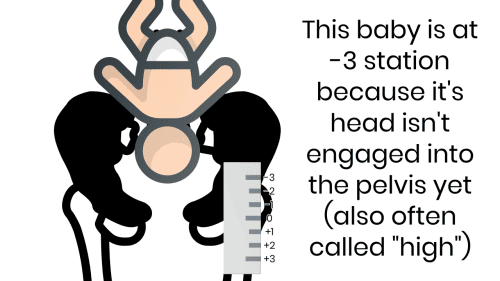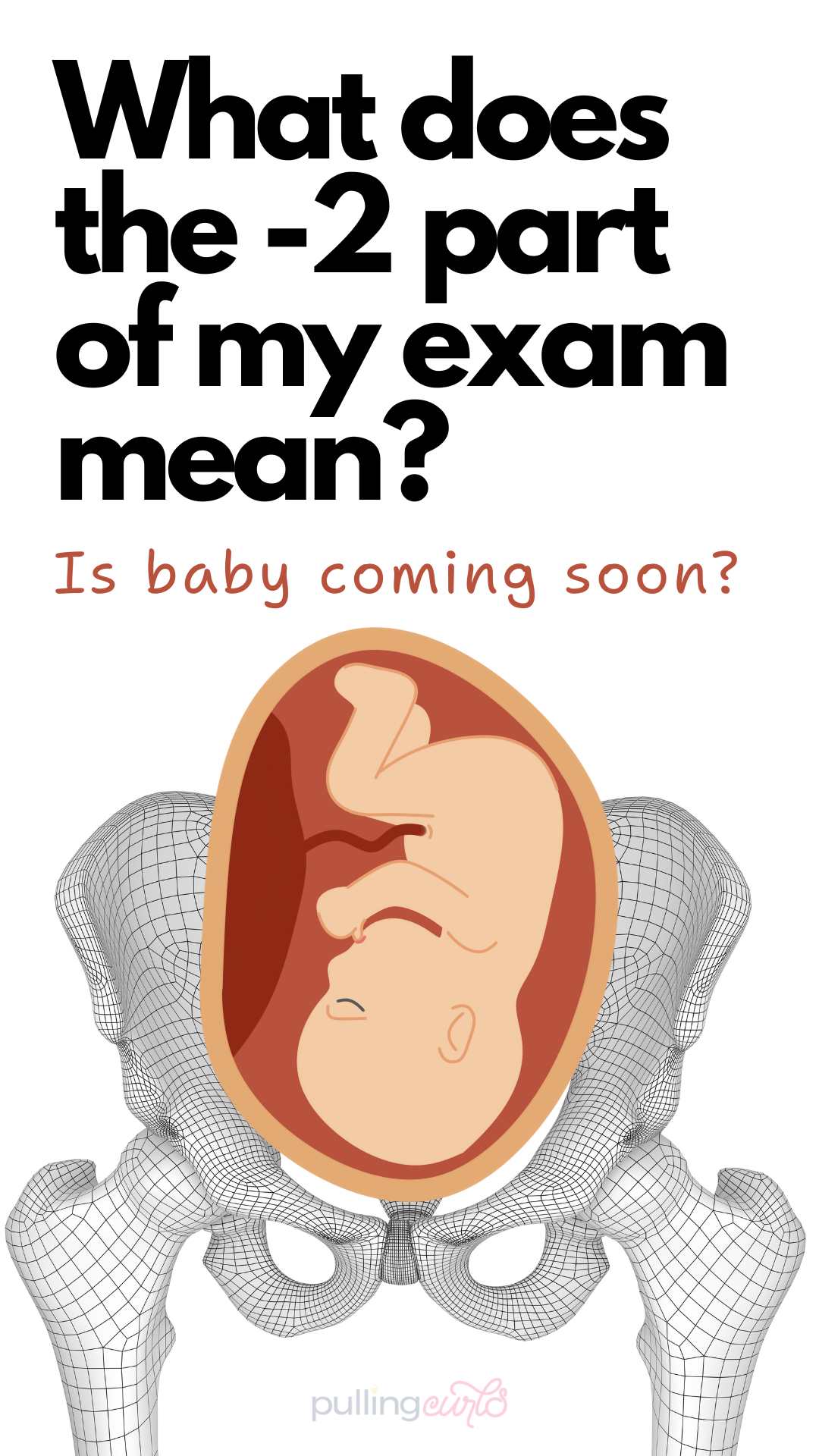So, you had a doctor’s visit and they said you were dilated to a number, but also said baby was -2? What does that mean (being negative isn’t usually a great sign). Today we’re going to talk about cervical exams and how they correlate to how baby is moving into the birth canal. That minus two is actually one of the most important indicator’s of baby’s birth canal movement, but keep reading!
But first off… how do I know so much about vaginal exams? Hi, I’m Hilary — a of people know me as The Pregnancy Nurse®. I’ve been a nurse since 1997 and I have 20 years of labor and delivery experience. I’ve felt a LOT of cervixes, so I’m a pro at this one. I’m happy you’re here and wondering. 🙂
What does -2 mean when checking cervix?
It refers to the baby’s station. That means how high or low they are in the pelvis. It is measured from -4 to +4.
-4 means that baby is very high in your pelvis (normally we just call that “high” — I rarely hear someone say -4).
+4 usually means that baby is crowning. Here’s a graphic that might help out:

We’re measuring the baby against the ischial spines of your pelvis (that is zero).
So, if your baby is -2 it means that baby is still pretty high in your pelvis, but it is at least engaged in your pelvis (otherwise it would be “high” or sometimes they say ballotable — meaning baby’s head hasn’t engaged in the pelvis and you don’t really feel it).
Honestly, I hate that your provider said those numbers but didn’t tell you what they mean, but providers are busy — which is why it’s awesome to get prepared a bit on your own (so you can save the BIG questions for them) — this is the ways way to do just that!
❤️🧡💛💚💙💜 I love, Love, LOVE that you’re here preparing — but I gotta ask if your partner is just as on board for how different things are going to be. If you’re thinking you’d like for you to BOTH get prepared I recommend this. Check it out!
What do all the numbers in the cervical exam mean?
A cervical check normally has a few components:
Pro Tip: Think of a head moving into a tight knit sweater. As your head pushes into it, it will thin out and open up — same idea for much of these numbers):
Cervical Dilation: How open the cervix is (it opens up as the head pushes through) — measured in centimeters
Effacement: How thick the cervix is (it thins out, or effaces, as the head pushes through) – measured in a percent
Station: Where the baby is in the pelvis (just talked about that above)
Those are the three we often talk about, but there are a couple more we’re feeling for
Position: where in the birth canal is the cervix located (in the back or near the front)
Consistency: Is it hard, or soft? what’s it feel like?
We also always want to check for the presenting part if we can — is the baby head down, or is another part pushing on the cervix?
Remember that a cervical exam is different from other pelvic exams you’ll have/had for a variety for reasons. This type of vaginal exam is really only done at prenatal visits or once you get into labor and delivery. It is done by a doctor, midwife or a trained RN. Learn more about this in my post on vaginal exams.
Also, you may be wondering the signs of labor — and I have a handy checklist here for you:
What does this mean for me going into labor?
I know the big question is how all of these (and that -2) correlate into going into labor. The thing is that it mostly depends on contractions and what they’re doing. Are they pushing baby into the birth canal, or are you fairly contraction-free at this point?
The minus two doesn’t mean all that much. That’s what most people are before labor starts. Some people still walk around at 0 station or +1 and their bladders really hate them. It doesn’t mean they’re going to go into labor soon.
Remember: what your cervix is right now doesn’t mean it can’t stay that way for days, or it could also change in a few hours with fruitful contractions from your uterus. It only tells what it is right now, it doesn’t predict the future. Or, tell when you will be giving birth.
Active labor is when your cervix is actively opening. Meaning we check it now, and if we checked it again in an hour it’s changing. For most people that isn’t until you’re 4-6 centimeters with good contractions. You have to have both of those things.
Hopefully this helped you understand it all more. Remember, your provider really can’t answer EVERY question in appointments (although I wish they could) — so if you do some preparation on your end it can make those appointments mean so much more for you. The Online Prenatal Class for Couples is the easy way to get prepared.
Looking to get prepare for your birth? I have some easy options for you!
~~~~~~~~
– Worried you’re missing something? Grab my pregnancy planner so you don’t miss a thing!
– Thinking about an induction? Grab Inductions Made Easy to feel prepared in just 20 minutes!
– Wondering how to get that baby OUT? Grab Going Into Labor Made Easy so you know how to (and not to) do it!
– Postpartum got you anxious? Check out Postpartum Care Made Easy so you can stay SAFE even when all your attention is on that little on.
🚨 AND if ALL OF IT has got you on edge The Online Prenatal Class for Couples is perfect for you — You’ll feel so ready before you even know it!
~~~~~~~~
No matter WHERE you are at in your pregnancy journey, we have resources that can help!
Not sure we’re a good fit check out my free class — It’s your first step towards being your own birth boss.









Leave a Reply